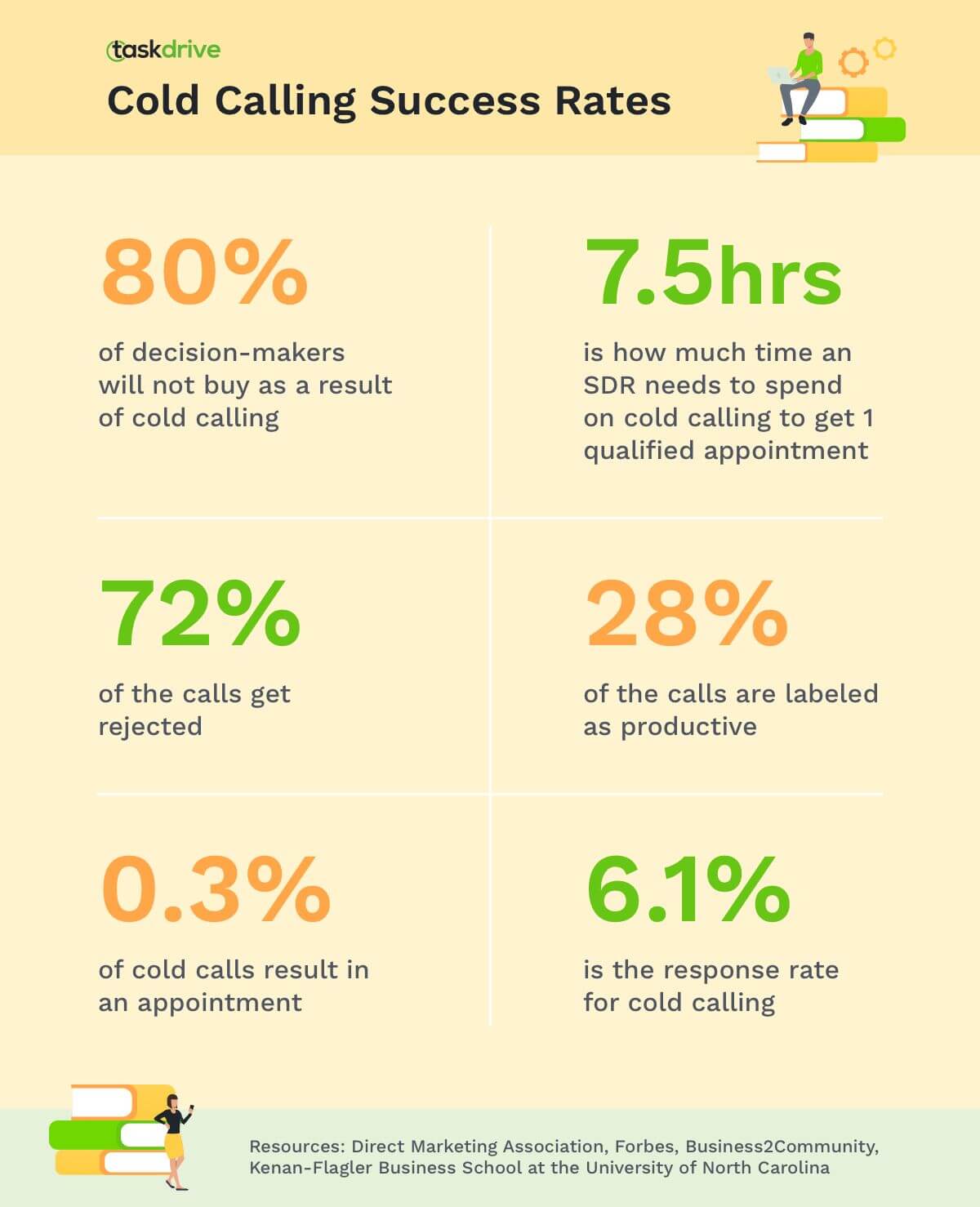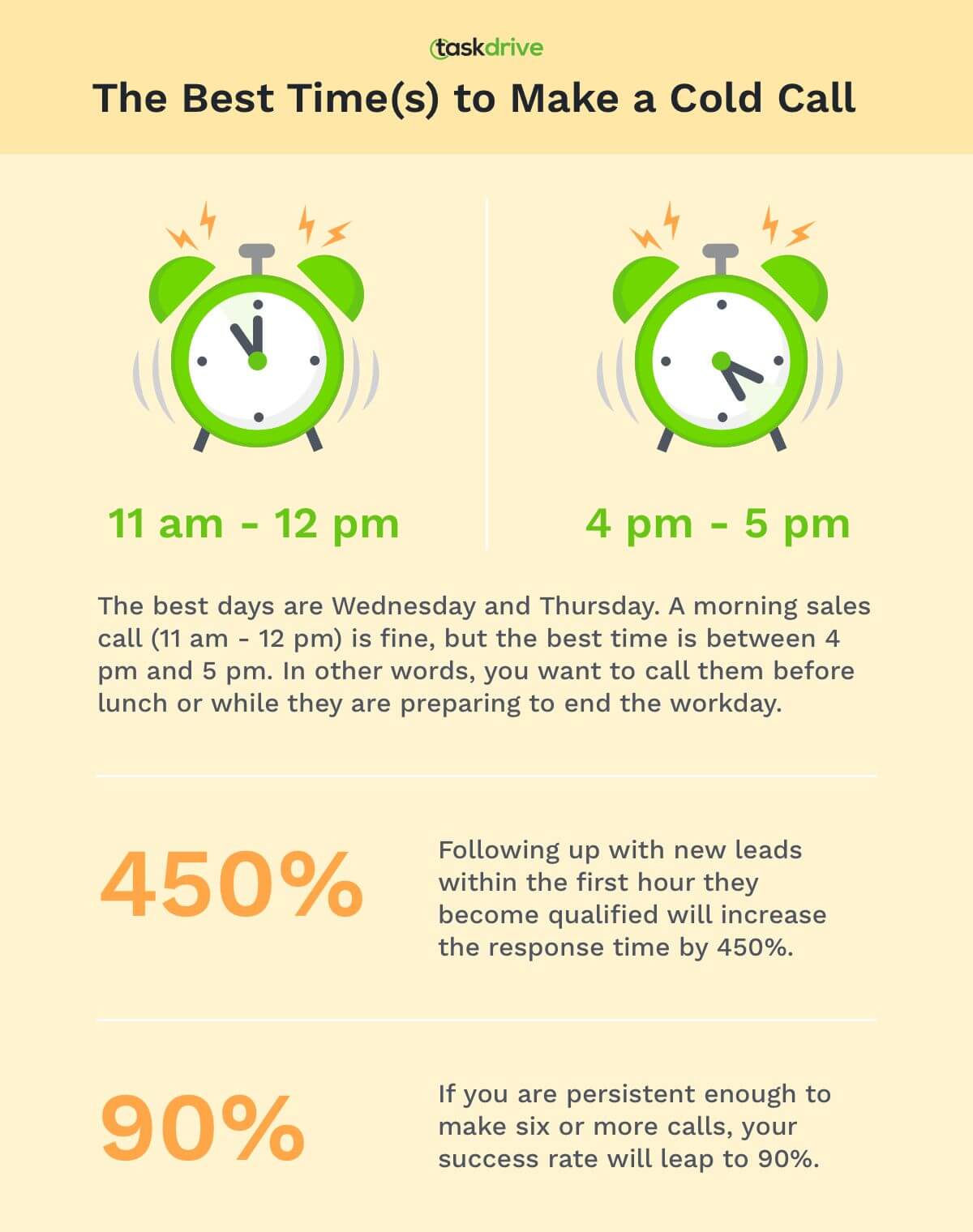A traditional sales technique, cold calling has been around for decades. Its goal is to reach out to businesses and individuals who have not initiated any interest with the company that is calling them.
And even though some claim that this early stage technique is outdated, it is nonetheless still an integral – and often essential – aspect of sales approach in a large number of companies. The reason for this is simple – there are not enough warm leads.
Also, cold calling remains the fastest, lowest-cost, and most direct technique to initiate a sales process.
However, it would be a lie to say that cold calling isn’t tricky. It is not easy to just call someone on the phone and offer them your product or service. Moreover, this method has lower conversion rates because cold leads do not expect to be called since there was no directed campaign or pre-introduction towards them.
That is why the majority of SDRs struggle with cold calling. They find it difficult to maintain a steady rate of success throughout their calls, find the motivation to go through a day full of rejections, and also stay in their position for more than a year.
Luckily, TaskDrive has prepared the ultimate cold calling guide for SDRs. In it, you will find various tips on how to approach your cold calls even before you start dialing the numbers.
But first, let’s see some interesting statistics about cold calling that prove how discouraging it can be for SDRs.
What Is the Success Rate of Cold Calling?
According to various sources, the success rate of cold calling ranges anywhere between 0.3% and 6%. The results vary depending on the way a study was conducted, but in all of them, a cold call was deemed successful if it resulted in an appointment.
Below are four different studies showing different success rates:

But even that 6% is quite discouraging, especially for someone making cold calls all day long. That is why and SDR needs to do their best to master the art of cold calling. And the best way to start this process is to avoid common mistakes.
Download the complete cold calling guide in PDF + free scripts and additional resources
The Most Common Cold Calling Mistakes

Cold calling is scary, which is one of the main reasons SDRs make some mistakes when reaching out to prospects on the phone. However, if your team puts some thought into this outreach method, you will see results sooner than expected.
Avoiding the most common cold calling mistakes is a good place to start your journey to mastering the art of cold calling.
Not knowing who you’re calling
You can never be overprepared for a cold call. Gathering all sorts of information about your prospect is something you should do before you dial that number.
Remember that, once the person on the other end of the line picks up the phone, you will only have 10-20 seconds to grab their attention. Mispronouncing the person’s name, dialing the wrong number, talking to the wrong decision-maker – all of these can cost you a deal.
It’s fine to be confident in your skills and charm, but you always need to prepare beforehand.
Not paying attention to the first sentence
In other words, your opener is crucial. If you start with ‘Hey, this is Pete from Company X. How are you doing today?’ and follow with a dull sequence, you’ve probably already lost their attention.
Don’t use the same old boring introduction that every other salesperson uses. This will surely annoy your prospects and make it obvious that you are just another salesperson.
Instead, break the pattern by using a more creative or provocative opener. Don’t be too nice, but be in control when the call starts.
Know exactly what you are going to say in the first seven seconds of the call. Use a pattern interrupt to catch the person off guard because those seven seconds will buy you another 30 seconds and increase your chances of scheduling another call or appointment.
Having the wrong mindset and energy when calling
When it comes to in-person cold calling, your mindset is extremely important. A mere thought of having to talk to someone is daunting for so many SDRs.
To be successful with your cold calls, make sure to have the right mindset before even dialing the number. This will happen if you truly believe in the product or service your company offers. On the other hand, if your only motivation is money, you are less likely to make it.
And remember one thing – it’s okay to interrupt your prospects in the middle of other activities if you do it nicely. After all, that is what SDRs do all the time.
Not speaking loudly or clearly enough
When on a cold call, it is important to use every opportunity to amplify your message. This includes capturing your prospect’s attention with your voice and delivery.
Just like actors need to project their voice with a certain volume and clarity, so does an SDR have to make the most of their voice because, after all, it is the only ‘weapon’ at their disposal.
By amplifying your energy, sentiment, and pronunciation, you will be able to convey the message as you intended.
So, instead of slouching in your chair, mumbling into the phone, and having a monotone cadence when speaking, do exactly the opposite:
- Assume a power pose (stand up).
- Project your voice as if you were talking to someone who is 10 feet away.
- Speak clearly, overemphasizing the key points you want the prospect to understand.
Sounding like a salesperson
Finally, whatever you do, make sure not to sound like a salesperson. Always keep in mind that your prospects don’t know you and they probably get a lot of cold calls, which is why they will hold their guard when talking to you.
That is why you need to sound different than other salespeople who call them every day. So, instead of talking like someone whose goal is to sell something, talk like your only goal is to help your prospect. That is how you will transform your approach from the one of a salesperson to the one of a business person.
Here are some cold calling tips and tricks that will help you with this:
- Always confirm availability. Ask them if they have a moment so you can proceed with the call.
- Forget your product. In other words, minimize how much you talk about your company, products, services, and features. Instead, focus on the prospect and their pain points.
- Focus on value. If you really have to mention your product (and you will most probably have to do it at some point), make sure you focus on the improvements it can make for your prospect.
- Ask good questions. This will help you keep the conversation going, make it more about the prospect, and also qualify them before proceeding with the later stages of the sales cycle.
Cold Calling Guide – How to Do It Right

Great, you know what mistakes to avoid in your daily efforts to convert prospects. Now you can move on to learn some of cold calling best practices and take your skills to the next level.
Research, research, research
Building rapport with your prospect is probably the single most important thing you need to do while on a cold call. But to be able to do it, you need to know what they’re up to and what segment they fall into. And there is only one way to learn that – through research.
The first thing you should do is check their LinkedIn profile to see:
- recent changes in employment
- the content they have created, shared or engaged in
- influencers they follow
- groups they are members of
These will help you tailor your approach by using common language and focusing on the topics that matter most to them. And that is how you can turn your cold call into a warm one. Simply identify your opportunities, engage with the content they created, and get involved in their conversations.
Pro tip: Knowing as much as possible about your prospect is important, but so is calling the right phone number. When conducting your lead research, make sure to also figure out the phone numbers you need to call to get the right person on the phone.
Sure, all this research takes time, but be certain that it will make you stand apart from the rest and it will pay off in the end.
Create a solid framework
Just like you use email templates to save time and improve the outcome, you should also consider using cold calling scripts.
No worries, this cold calling guide has got you covered. Here are some common steps to framing a nice script:
Intro and Opener.
1. Short and simple. Sounds familiar? Sure, you could say who you are, but remember what we mentioned about the introduction.
Instead of sounding just like every other SDR, try to be original. For example, start by saying something you have in common with the prospect to personalize the conversation early on during the call.
Of course, all of this while keeping the introduction short and simple.
2. Reason. Why are you calling them in the first place? Is it maybe because you have something to offer?
You need to be direct, but not mention your product right away. Instead, show how you can help, which leads to the next point.
3. Show value. Talk about your offer through a value proposition. Make sure to mention the companies you are helping, the results you’ve achieved together, as well as what exactly makes you stand out from other similar companies in your industry.
4. Asking questions. Never assume. Instead, ask if they are interested in using the product or service. Also, you could qualify prospects by using leading questions.
5. Close. You always need to have a good close. What will happen after the call? Booking a demo? Is somebody else going to take them over? Whatever it is, you need to be clear about what step you want to take next and lead the prospect that way.
Focus, focus… Focus!
Your smartphone, coworkers chatting, coffee break… With so many distractions around you, it can be difficult to focus. Yeah, sure. But tell that to your team leader.
Fighting distractions and focusing on tasks is something everyone struggles with. To overcome this, try setting personal goals and creating an environment that will help you focus.
For example, early in the morning, set a number of calls you are planning to make and then reward yourself after you’ve hit the number. Organizing your day like this can do wonders for improving your focus and becoming more efficient in the long run.
Prepare for objections/rejection
Objections are an integral part of cold calling, and that is something you need to accept. But accepting it doesn’t mean you should do nothing about it. Quite the opposite, you should prepare for objections so that they don’t surprise anymore.
Experience is key here – the more calls you make, the better you will be prepared for handling them.
Take a look at some of the most common objections you will encounter while cold calling.
- “Sorry, but I can’t talk now.”
A natural reaction would be to withdraw from the battlefield. And in a way, that is what you should do. But not before you ask them about the best time when you can have a short five-minute call. This way, you set expectations and ask for a low level of investment.
- “Why don’t you send an email?”
Or “I just want to get you off the phone”. No problem, but first ask them what you should include in the email. Also, follow up with a set of questions that will help you qualify them. This way, you will slowly but surely get them invested in the conversation.
- “Can we talk in a month?”
Now, this one is a bit different. It will happen when they can’t make a decision, and it is often because a senior decision-maker needs to be involved. In this case, ask who will be involved, if you can join, and also what you need to bring to the meeting.
When a prospect asks for more information, it means that you are not a priority for them. This is exactly when you need to show value.
Some ways to do this include:
- Starting with a simple request to create a state of compliance.
- Asking a relevant question based on the information they provided.
- Asking follow-up questions based on the response you get. Make sure you listen carefully and show that you can help them solve their challenges.
- Acknowledging that they don’t have time, but trying to schedule an appointment.
Pick the right time
Your pick-up rate largely depends on when you make the call. Just like with emails, you want to reach out at the best time during the day.
So, what is the best time to make a cold call?

Never a failure, always a lesson
Or, in other words, ‘Learn from your cold calls’.
Expecting to become a cold calling master overnight is just unrealistic. That is why you need to make learning your primary goal. To be precise, you should reflect on each of your calls and try to figure out what can be done better next time.
Find out what are the parts where you struggle most. Then, when you know the exact points where most prospects tend to object or reject you, rewrite that part of the script.
You could also try new value propositions, methods of personalization, or close the call by asking for a lower investment on their side. Also, make sure your open-ended questions are making the prospect talk.
One more thing – record your calls and listen to them later to identify the points that you could improve.
Only when you have got through your entire script for more than half of your cold calls will you know you’re doing it the right way.
On the call
All this sounds nice and great, but when you’re actually on the call, you can easily forget the steps listed above.
Here is a list of the cold calling techniques that work to remind you to stay on the right track during the call:
- Set your eyes on the prize. In other words, always have your goal in mind, whether it is to schedule appointments or demos. This will keep you focused and motivated while on the call.
- Ask open-ended questions. Instead of asking “Are you satisfied with your current CRM?”, try with “Where does your current CRM fall behind?”
- Drop social proof points. By proving results, you build trust with your prospects. When you mention statistics, case-studies, or some of the most important accounts that show you’ve already helped other companies, you will be one step closer to your goal.
- It’s always about them. Just like we already mentioned, instead of focusing on your company, product, or yourself, let them talk about their challenges, roles, and interests. This makes your prospects feel good and also helps you get valuable insights.
- Listen. Apart from getting them to talk about themselves, show your interest in what they have to say by actively listening and asking specific follow-up questions.
- Be aware of your voice and language. You should change your tone based on the situation. For example, if the prospect is in a rush, stick to short questions and explanations. If they’re confused, simplify your language as much as you can and try to educate them.
- Maintain a positive attitude. Above all, whatever happens, always stay positive. Don’t let the prospect make you nervous or angry. Remember that objections and rejection are fine as long as you’re learning.
Leave a voicemail
You can’t expect your prospects to always pick up the phone. They may be busy doing important tasks, commuting, or they are in a meeting.
In that case, you know what to do – leave a voicemail. Here is a voicemail template that you can use:
Hello [Name],
This is X from Company Y.
I’m calling because I think I may be able to help with [whatever their problem is]. I wanted to see if it would work for us to have a quick call to find out more about it.
You can reach me at [your phone number].
Thanks, [Name].
As you can see, it’s short, to the point, and leads the prospect toward the next step – very similar to a cold email.
If they haven’t replied to your first voicemail, you can always do a voicemail follow-up. Since they already know who you are (if they have listened to the first voicemail), this is a script you can use to follow up:
Hello [Name],
I left a voice message last week regarding X. I thought this was a good time to reach out.
Just to remind you, we [restate your value proposition], and I would love to show you how you can achieve [result].
Would you be interested in scheduling a call and learn more?
Thanks, [Name].
Conclusion
There you have it. A comprehensive list of cold calling techniques that really work and have proved valuable for a number of companies worldwide. Why wait any longer?
Hopefully, you will start implementing all or some of the cold calling techniques from this cold calling guide and see the difference in contact rates, the number of appointments, and eventually, the number of sales generated from your calls.
When the going gets tough, always remember that cold calling is among the most difficult and least favorite elements of the sales process. However, that doesn’t mean that practicing and striving to advance is in vain.
Avoid the most common mistakes, learn to cold call the right way, use cold calling scripts, and always try to stay up-to-date with the latest trends. If you follow the tips listed in this cold calling guide, you will become a cold calling master sooner than you may expect.



